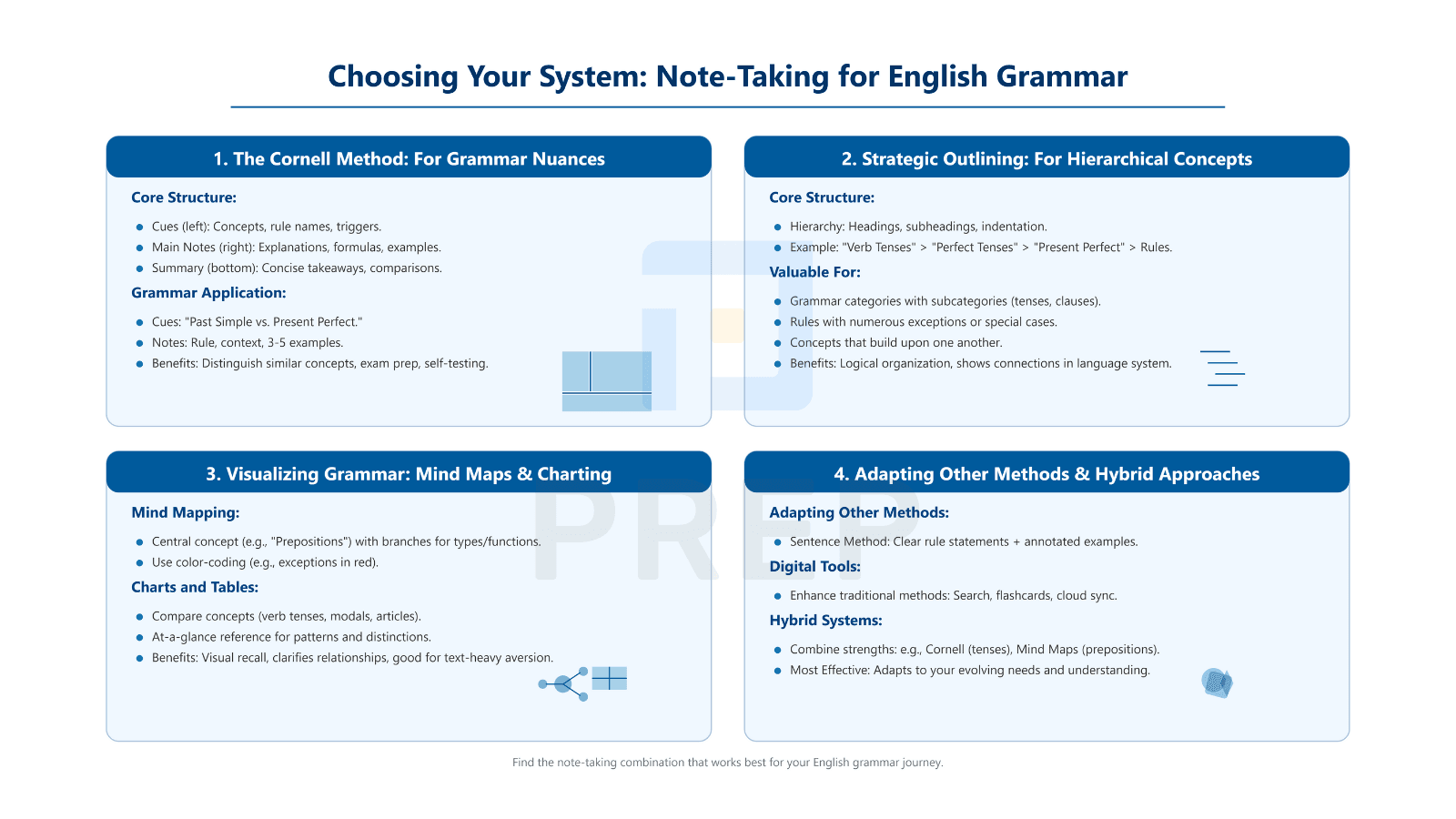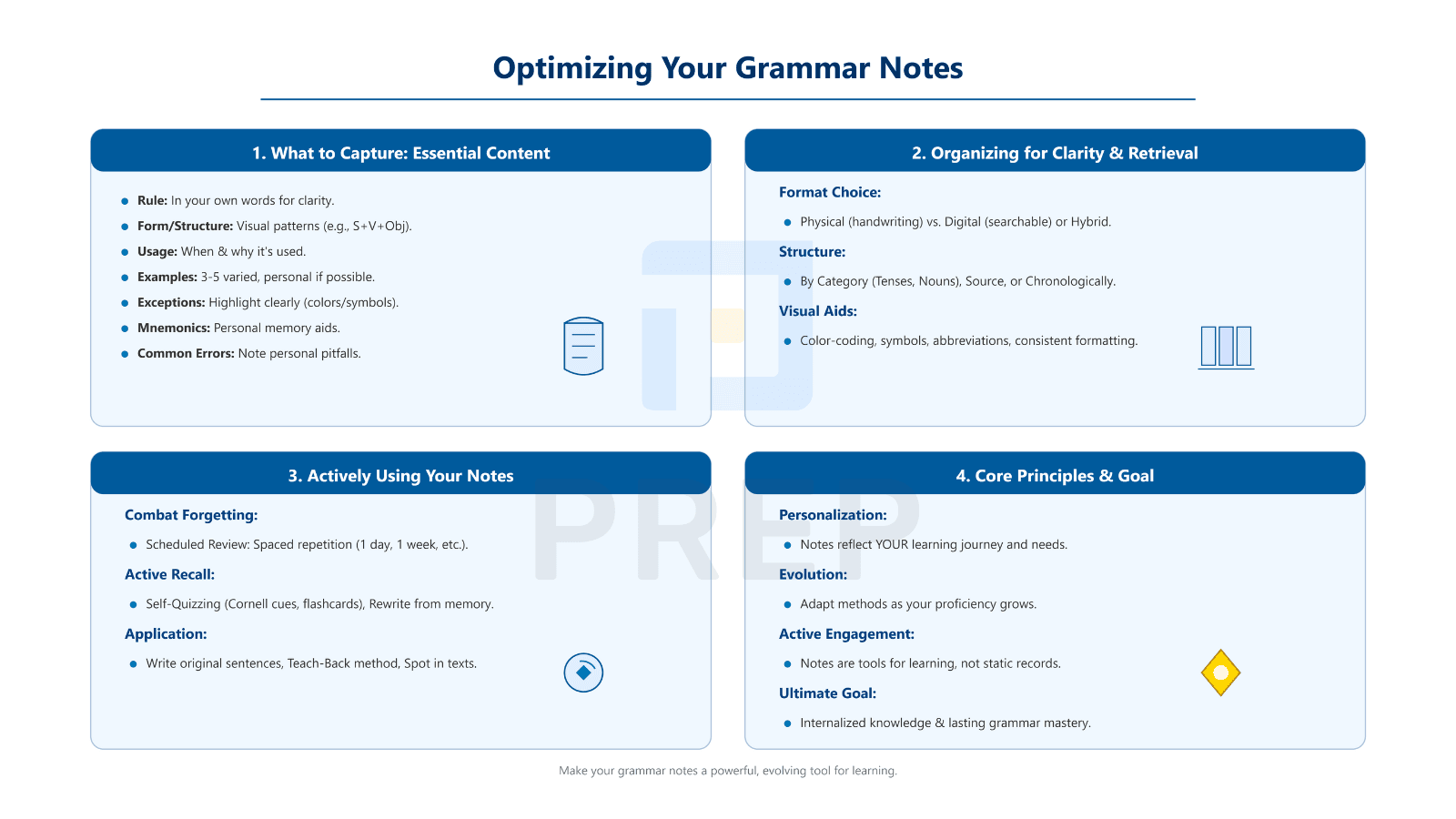The Ultimate Guide to Effective Note-Taking in English Grammar: Learn Faster & Remember More
Mastering note-taking in English grammar is essential for language learners who want to accelerate their progress and retain complex rules. This comprehensive guide provides proven strategies and practical techniques to transform your grammar notes into powerful learning tools that enhance both understanding and long-term retention.

I. Unlocking Grammar Mastery: The Critical Role and Core Principles of Effective Note-Taking
Most language learners struggle with retaining complex English grammar patterns, often forgetting rules shortly after studying them. Effective note-taking in English grammar transforms this experience by creating a bridge between passive exposure and active mastery. When you create personalized notes for English grammar concepts, you engage multiple cognitive pathways that dramatically improve both understanding and retention, while building a customized reference tailored to your specific challenges.
The most powerful grammar notes consistently incorporate several key elements: clarity that distills complex concepts into manageable chunks; absolute accuracy that prevents cementing errors; rich, diverse examples showing various contexts and applications; and clear highlighting of exceptions and common pitfalls. These elements transform your note-taking in English grammar from mere information recording into dynamic learning tools that prevent repeated mistakes and accelerate mastery.
Your approach to note-taking in English grammar should reflect your unique learning style and specific goals, whether you're preparing for exams, improving conversational fluency, or mastering professional writing. Visual learners might benefit from color-coded charts, while reading/writing-oriented learners might prefer detailed written explanations. English grammar note making examples that work for others might not work for you, so experiment with different approaches and adjust based on what proves most helpful in practice, allowing your system to evolve alongside your expanding knowledge.
II. Choosing Your System: Proven Note-Taking Methods Specifically Adapted for English Grammar

1. The Cornell Method Deconstructed for Grammar Nuances
The Cornell Method offers a structured approach that works exceptionally well for organizing complex grammar concepts when note-taking in English grammar. This system divides your page into three distinct sections—cues, main notes, and summary—creating an organized framework for capturing and reviewing grammar information.
Core Structure:
-
Cues Column (left, narrow column): Write grammar concepts, rule names, and trigger questions here.
-
Main Notes Section (right, wider column): Record detailed explanations, formulas, and examples.
-
Summary Area (bottom): Create concise takeaways of the main grammar points.
Grammar-Specific Application:
-
In the cues column, write clear identifiers like "Past Simple vs. Present Perfect" or "Conditional Type 2."
-
In the main notes section, include the rule formulation, usage contexts, and 3-5 example sentences showing different applications.
-
Use the summary area to create a mini-reference with the most essential points or a comparison chart for related grammar concepts.
English grammar note making examples using the Cornell method might include a page with "Present Perfect vs. Past Simple" in the cue column, detailed explanations of both tenses with example sentences in the main section, and a concise comparison summary at the bottom. This method is especially beneficial for learners who need to distinguish between similar grammar concepts or who are preparing for exams where quick recall is crucial. The cues column serves as an excellent self-testing tool for effective note-taking in English grammar.
2. Strategic Outlining for Hierarchical Grammar Concepts
Outlining is particularly effective for mapping the hierarchical nature of grammar, where main categories branch into subcategories with various rules and exceptions. This method creates a visual representation of how grammar concepts relate to one another, helping you see the structure of the language system.
The outlining method uses a clear hierarchy of headings and subheadings, with indentation showing relationships between concepts. For example, "Verb Tenses" might be a main heading, with "Perfect Tenses" as a subheading, and "Present Perfect" as a further subdivision, followed by formation rules, usage contexts, and examples at the most detailed level.
This approach proves especially valuable for note-taking in English grammar when dealing with:
-
Grammar categories with multiple subcategories (like tenses or clauses)
-
Rules with numerous exceptions or special cases
-
Concepts that build upon one another
Outlining benefits learners who appreciate logical organization and need to see how individual grammar rules fit within broader language patterns. This method transforms seemingly isolated grammar points into a coherent, interconnected system.
3. Visualizing Grammar: Mind Maps and Charting Techniques
Visual approaches to grammar note-taking harness the brain's ability to process and recall visual information, making complex relationships more immediately apparent.
Mind Mapping for Grammar: Mind maps radiate from a central concept, with branches showing related ideas and connections. For grammar note-taking, the central node might be a grammar category (e.g., "Prepositions"), with main branches for different types or functions, and sub-branches for specific usage patterns and examples. Using color-coding enhances this method—for instance, marking exceptions in red and common uses in green.
A preposition mind map might show spatial prepositions on one branch, temporal on another, and idiomatic usages on a third, with specific examples clustering around each type.
Grammar Charts and Tables: Structured visuals work exceptionally well for comparative grammar concepts. Tables comparing verb tenses, modal verbs, or article usage provide at-a-glance reference for patterns and distinctions. For example, a modal verb chart might have columns for each modal (can, could, may, etc.) and rows for different functions (ability, permission, possibility), with example sentences in each cell.
Visual note-taking methods particularly benefit learners who struggle with text-heavy approaches or who need to grasp relationship patterns between grammar concepts. These techniques transform abstract rules into spatial information that's often easier to recall during speech or writing.
4. Adapting Other Methods & Hybrid Approaches
No single note-taking method perfectly addresses all grammar learning needs, which is why adapting and combining approaches often yields the best results.
The Sentence Method, where main points are written as complete sentences, can be adapted for grammar by formulating clear rule statements followed by annotated examples. This works particularly well for more straightforward grammar concepts or for creating quick-reference sheets.
Digital tools significantly enhance traditional note-taking methods for grammar. Apps with search functionality allow quick retrieval of specific rules, while flashcard programs incorporate spaced repetition for systematic review. Cloud-based notes enable cross-referencing and updating your grammar knowledge from any device.
Many successful language learners create hybrid systems that leverage the strengths of multiple methods. You might use Cornell for complex tenses, mind maps for prepositions, and tables for modal comparisons—all within a single, comprehensive note-taking system.
The most effective approach is one that adapts to your evolving needs. As your grammar understanding deepens, your note-taking method should evolve accordingly, potentially shifting from highly detailed notes for beginners to more nuanced, exception-focused notes for advanced learners.
III. Crafting and Optimizing Your Grammar Notes: Content, Structure, and Active Application for Lasting Mastery

1. What to Capture: The Essential Content of Your Grammar Notes
Beyond the method you choose, the actual content you record fundamentally determines your notes' effectiveness. Comprehensive grammar notes should consistently include:
The Rule Itself: Express the grammatical principle clearly and concisely, using your own words rather than textbook language. This personal reformulation enhances understanding and retention.
Form/Structure: Include formula-like structures showing patterns. For verb tenses, this might be "Subject + was/were + verb-ing" for past continuous, making the pattern immediately apparent.
Usage Contexts: Specify when and why this grammar feature is used in English. For example, present perfect notes should clarify its use for past actions with present relevance, unfinished time periods, and experiences without specific times.
Signal Words/Phrases: Note words that typically accompany specific grammar structures, such as "already" and "yet" with present perfect, or "unless" with conditionals. These serve as valuable clues when constructing sentences.
Varied Example Sentences: Include at least 3-5 diverse examples demonstrating different subjects, contexts, and sentence types (questions, negatives, statements). Personal examples relevant to your life are particularly memorable.
Key Exceptions: Highlight irregular patterns or exceptions prominently, perhaps using different colors or symbols. For irregular verbs, note the specific irregular forms rather than trying to memorize patterns.
Common Errors: Record mistakes you personally make or those typical for speakers of your native language. This creates specific awareness of pitfalls to avoid.
Personal Triggers/Mnemonics: Develop memory aids that help you recall challenging rules. These highly personalized elements often make the difference between remembered and forgotten grammar points.
2. Organizing Your Grammar Notes for Clarity and Easy Retrieval
Even brilliantly crafted notes become useless if you can't locate information when needed. Strategic organization transforms your note-taking in English grammar from a collection of information into a practical reference tool that supports ongoing learning.
When considering physical versus digital formats, each offers distinct advantages. Physical notebooks provide the cognitive benefits of handwriting and freedom from distractions, while digital systems offer searchability, editing flexibility, and portability. Many successful learners maintain a hybrid system—physical notebooks for initial learning, with key points transferred to digital formats for long-term reference.
Effective Structuring Systems:
-
Category-Based Organization: Arrange notes by grammatical category (Tenses, Nouns, Modals, etc.), with clear section dividers or digital folders. This intuitive approach to note-taking in English grammar makes logical sense but requires good indexing for cross-referential concepts.
-
Source-Based Organization: Structure notes according to learning resources (textbooks, courses, etc.), preserving the pedagogical sequence of your materials. This approach works well when following a curriculum but benefits from cross-referencing for related concepts from different sources.
-
Chronological Organization: Record notes sequentially as you learn, creating a timeline of your grammar journey. This approach requires a comprehensive index or tagging system but shows your progress over time.
Visual Organization Tools:
English grammar note making examples often incorporate visual elements to enhance retrieval—for instance, using blue for tenses, green for prepositions, and red for exceptions. Developing personal symbols and abbreviations (such as "PP" for present perfect or "C2" for second conditional) streamlines your note-taking in English grammar, while consistent formatting with standardized headings and spacing improves scanability.
The most efficient system combines multiple organizational elements tailored to your learning preferences and reference needs. Regular review and restructuring keep your notes optimized as your grammar knowledge expands.
3. Beyond Passive Recording: Actively Using Your Notes to Embed Grammar
Notes that merely sit unused represent missed learning opportunities. The true power of note-taking in English grammar emerges when notes become tools for active learning and application rather than static records.
The forgetting curve shows that without review, we rapidly lose newly acquired information. Scheduled review sessions—ideally incorporating spaced repetition principles—counteract this natural forgetting process. Rather than random reviews, strategically increasing intervals between review sessions (1 day, 3 days, 1 week, etc.) optimizes retention while minimizing time investment when applying your note-taking in English grammar.
Active Recall Strategies:
Self-quizzing transforms passive notes into active learning tools. Cover the main notes in your Cornell system and attempt to reconstruct rules and examples from memory using only the cues. Alternatively, create questions on one side of flashcards with answers on the reverse, forcing active recall rather than passive recognition. English grammar note making examples often incorporate these testing mechanisms directly into the note format.
Rewriting rules from memory on a separate sheet before checking against your notes identifies gaps in understanding. This "retrieval practice" strengthens neural pathways more effectively than repeated reading and transforms note-taking in English grammar into an active learning process.
Application Exercises:
Writing original sentences using targeted grammar points moves beyond theoretical understanding to practical application. Challenge yourself to create increasingly complex examples that still maintain grammatical accuracy.
The "teach-back" method—explaining grammar concepts to someone else (real or imaginary)—reveals genuine comprehension levels. If you can clearly explain a concept, you truly understand it.
Identifying targeted grammar structures in authentic texts bridges the gap between isolated practice and real-world usage. This trains your brain to recognize correct patterns in context and represents one of the most powerful ways to leverage your note-taking in English grammar.
True grammar mastery comes not from perfect notes but from the active engagement process that transforms those notes into internalized knowledge. Your notes should be living documents that evolve through use.
With these strategies, you're now equipped to transform your note-taking in English grammar from simple record-keeping into a powerful system for accelerated learning and lasting retention. The journey to mastering the intricacies of English grammar begins with your next note—make it count. Remember that effective note-taking evolves alongside your language proficiency, becoming more sophisticated as your understanding deepens. By consistently applying these principles and techniques, you'll develop a personalized grammar reference that no textbook could provide, reflecting your unique learning journey and relationship with the language.

Hi I'm Chloe, and I am currently serving as an Product Content Administrator at Prep Education. With over five years of experience in independent online IELTS study and exam preparation, I am confident in my ability to support learners in achieving their highest possible scores.
Comment
Premium content
View allPersonalized roadmap
Most read












